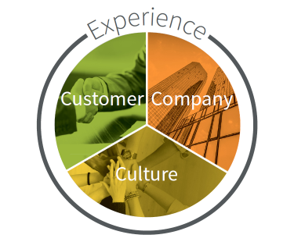Using the E + 3 C’s Orientation Framework to Improve Your Onboarding Program
“First impressions matter.” You’ve probably heard this phrase many times. This quote echoes in my head from the early days of my career – as do several other tips for “getting off on the right foot” when starting a new job. (You’ve probably heard them, too – “smile,” “make eye contact,” “offer a firm handshake,” and “be professional, yet authentic.”) But it’s not just employees themselves who should take note of this advice. Organizations as a whole should pay attention to it, too.
As a company, you have one chance to make a good first impression on your new hires. What would they say about the impression you make?
In one previous role, I was taught my company’s contracting and legal process on Day 1. It was important information, but it was also a skill I wouldn’t actually use for another three months. By the time I was ready to use it, I had completely forgotten all the juicy details that would allow me to complete the task effectively. It had me wondering, with some dread, “What did I just get myself into?”
You’ve probably experienced a similar situation at some point in your career, right? In truth, many of us struggle when deciding what’s relevant to share with our new hires during orientation. Yes, there are always some topics that you must spend time on, such as safety and compliance. But beyond that, what do you actually need to cover in Day 1 of orientation?
Simplify Your Day 1 Objectives: Two Simple Actions for Day 1
Rome wasn’t built in a day. You can’t expect to bring your new hires fully up to speed on all aspects of the business on Day 1, either. Instead, stay focused on what you can achieve. In all likelihood, your new hires are starting their new roles with both excitement and apprehension. They may be experiencing a variety of thoughts, including:
- “I can’t wait to start!”
- “Have I made the right decision (for me and my family)?”
- “I hope I fit in.”
On Day 1, make every effort to do two simple things:
- Reaffirm their decision to join your company
- Amplify their excitement
The way you achieve both these goals is by engaging new hires in the compelling story of your business. Storytelling is important. We’re all drawn to stories – it’s the way we’re wired. Films, books, and games can take us on voyages of discovery. Your business, too, has a great story to tell. What we tend to find, however, is that many organizations struggle to tell their stories in compelling ways.
To do this, I want to give you a proven framework that has helped many organizations create great first impressions and energize their talent of tomorrow: the E + 3 C’s framework.

Dissecting the E + 3 C’s Framework
Step 1: E = Experience
This is the underlying foundation of the framework. It isn’t exactly rocket science, but it’s amazing how many companies lose sight of the experience when they engage their new hires. Remember that Day 1 isn’t just about the information you share but also the experience you deliver. The adage “you only get one chance to make a first impression” exists for a reason!

I recently met with a well-known creative agency that employs some of the brightest creative talent in the world. This agency’s orientation session was a four-hour slog through the business via PowerPoint presentations. Leaders of the business didactically took turns addressing the group (with varying levels of skill and success) from the front of the room. Hardly reflective of the culture they were looking to foster, right?
The one rule of thumb to make your orientation content more engaging (and scalable to boot) is to design it to be experienced around the new hire table instead of from the front of the room. Instead of being leader-led, make the experience facilitator-led. There’s a significant difference for the participant. Create space for genuine dialogue among new employees and encourage curiosity. Ultimately, doing this will require new hires to “switch on,” and it will drive intellectual and emotional engagement.
Step 2: C1 = Customer
As Simon Sinek would say, “Start with why.” It doesn’t matter if you’re a B2B or B2C – we all have customers of some sort, and they should inform the compelling reason your business exists. What problem does your organization help your customers solve? What would life look like for your customer without the services or products you provide? Bring the voices of your customers into the room, which can be done well using film as a medium, for example. Many new hires won’t have direct access to end customers, so being able to see your company’s impact on them can be very compelling. We often say that the customer experience can never exceed the employee experience. Helping new hires understand the value that your organization creates for customers – and how they can help deliver on this value – will create stronger emotional connections between your people, your company, and your purpose.
Step 3: C2 = Company
As we’ve already acknowledged, it can be overwhelming to join a new organization. You can accelerate their assimilation by generating an understanding of “the whole” – how all the pieces of the puzzle work together to collectively serve customers and achieve your vision.
Start by engaging your participants in the history of the organization. This is hardly a new tactic. In fact, traditionally, this is the most boring part of orientation, often conveyed using a timeline of dates on a slide that no one will ever remember. When done right, however, new hires can gain an appreciation for the relevance and importance of the company’s milestones and match those key dates with memorable cultural references.
Interactivity here is key! At our company, Root LLC, we created a series of mock movie posters that represent stages of our history in a fun, engaging way. Check out the posters below: The Dawn of Root, The Wild, Wild West, The Winds of Change, Racing to World-Class, The Journey Continues, and Wild Ride.

Next, explore your organization’s vision and high-level goals. Some organizations shy away from having strategy conversations during orientation, saying it’s too soon and that new hires won’t get it. While it’s true that getting into the nitty-gritty details can wait, a holistic lens can help people understand how they connect and contribute to strategic goals.
Finally, help new hires understand how to navigate the organization. This is often overlooked but is so important. For example, we were once asked to help a Fortune 10 company with their onboarding program. Their business was extremely complex, and when new hires joined the organization, they tended to be treated as though they were joining a new business group or function rather than the enterprise as a whole. They were never shown the holistic picture, so they never came to understand it. Over time, that created significant silos that affected their customer relationships. Root helped them create a visual “puzzle box top” or “systems view” of the organization as part of an immersive experience. It was so successful that new hires ended up having a better understanding of the business than their managers, which then created a desire to deploy the experience throughout the entire organization. It became a powerful silo buster for them.
Our advice: Don’t bother showing new hires a traditional org chart – no one will remember it or understand it. You need to make it “stickier” than that! You can message me for examples – I have lots and am happy to share. By sharing a true holistic picture, you’ll make your new hires better able to network and collaborate across silos toward shared goals.
Step 4: C3 = Culture
I’ve left the most important step for last, and it is culture immersion. Culture immersion can often mean the difference between a happy, engaged employee and an employee who checks out early. Unfortunately for most new hires, navigating their company’s culture can feel like trying to learn a bunch of new secret handshakes. If new hires don’t feel like they’re really a part of the culture, they can start to resent it, and sometimes they’ll even actively work against it. In a time of increased hybrid/remote work, this has only become more acute as people feel more isolated (regardless of the benefits of working from home).
Additionally, we often see organizations struggle to maintain a purposeful cultural direction when new leaders enter the business with conflicting cultural mindsets. If recruited leaders aren’t on board with their new company’s culture, it can have a snowball effect, dismantling years of careful culture crafting in just a few months as people follow and replicate the behaviors of their new leaders.
You need to immerse all hires – at every level – in your desired culture and demonstrate how it supports your strategy. (Always ask: “Culture in support of what?”) Explore with new hires the behaviors you reward and admire, as well as those that aren’t acceptable.
Finally, culture is something that can’t be mandated. If you’re thinking of standing at the front of the room and simply telling an audience about your culture, you can forget about making any behavior change. We often talk about taking an “inhale/exhale” approach to culture that makes employees feel like they’re an active part of your culture as opposed to a recipient of it. Take your new hires on a journey of self-discovery that allows them to connect the dots to their own value systems.
The Benefits of Perfecting Day 1 Orientation
Organizations that follow the E + 3 C’s orientation framework can expect to see an improvement in metrics, including new hire engagement, speed to competency, collaboration, and retention. In my experience, the E + 3 C’s framework will improve your onboarding program and represents approximately three hours of content. That’s all it takes to set up new hires to excel at your company on Day 1.
If the E + 3 C’s method worked for you, let me know! I love a great success story. Also, if you want a fresh perspective on your orientation and onboarding program, I’m happy to chat. Send me an email at chris.p.williams@rootinc.com.









